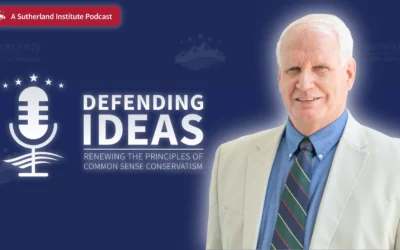
Written by Christine Cooke Fairbanks
April 25, 2024

U.S. presidential elections center on politics – polls, primaries, speeches, electoral votes. Americans should view elections as an opportunity to also learn about policy – the ideas that go into laws, regulations, executive orders, federal guidance and more.
The federal government has no constitutional, enumerated power in education, but its role has expanded over time. Practical policymaking limitations exist, especially in the executive branch, but still, presidential hopefuls make promises about education each cycle. And in fact, the bully pulpit, executive orders, and enforcement levers like agency rulemaking do give presidents and those appointed by them some power.
This election season, the leading candidates in both major political parties, President Joe Biden and former President Donald Trump, have experience being president, meaning they have a track record in education during their administrations. Plus, as candidates, they have campaign platforms.
As a result, the 2024 election season is a chance for state policymakers and voters to consider what a second term for either candidate might mean for education.
Biden education policy
Student loans and higher education
By far, the most notable focus of the Biden administration’s education efforts has been in student loan cancellation and forgiveness. With over $1.7 trillion student loan debt (federal and private) in the U.S., the cost of college and reducing loan debt has been a keen focus for many Americans. Biden has sought to address this through multiple iterations of loan forgiveness, with only some success. Biden’s attempt to cancel large sums of student loan debt via an executive order was rejected last year by the U.S. Supreme Court. His second effort was in creating a very lenient income-driven repayment plan called Saving on A Valuable Education or SAVE. Now, as of April 2024, he has put forward a new plan to cancel debt that comes from interest for those owing more today than when they took out their loan; automatically forgiving loans that have been in repayment for 20 years; offering relief to those who were in “low-financial-value programs”; and giving forgiveness to those who qualify for programs but haven’t applied yet.
Because actual lawmaking is outside the executive’s powers, the administration has often relied on executive action like making rules, pursuant to acts of Congress, to address student loan debt. Biden’s administration oversaw a continued extension of COVID-19 pandemic payment pauses (Trump first paused it during his term) and applying “waivers” to accounts so more borrowers could qualify for forgiveness programs.
During a second Biden term, Americans should anticipate further attempts to reduce student loan debt through federal government aid programs.
Furthermore, in a 2025 budget request, Secretary of Education Miguel Cardona has requested money for a number of ways to make higher education more affordable, from removing student loan origination fees to partnering with states to make two years of community college free for certain students.
Higher education is a key focus of this administration. State leaders can continue to find ways to innovate in higher education to make college more affordable, since the attention given to this issue at the federal level will inevitably cause constituents to bring the issue to their state public office as well.
K-12, charters and Title IX
Biden’s K-12 policy has had fewer splashy headlines but is not without movement and controversy. For example, his administration tightened rules for schools seeking grant funding from the federal Charter School Programs. Increasing regulation of charter schools is seen by some as a way of ensuring quality control, while others see such moves as creating obstacles for schools of choice.
This month, the Biden administration has stepped into the culture wars with the release of proposed Title IX rules, which clarify that sex discrimination now includes discrimination based on gender identity and change the due process rights of students accused of sexual assault on college campuses. Because Title IX funding flows to so many educational institutions across the nation – including private schools – the impacts are expansive as well as culturally significant, which is why it has been so controversial.
Looking forward, Biden’s administration has announced information on the Student Achievement Agenda, with a focus on improving attendance, offering “high-dosage tutoring,” and increasing summer, extended and after-school learning time. Ultimately the effort is aimed at overcoming learning loss and achievement gaps exacerbated by the COVID-19 pandemic.
Because K-12 has had less noticeable prioritization during this administration, and because it is traditionally difficult for the executive branch to make significant reforms without Congress, we might anticipate the same focus going forward. However, policymakers and school leaders will want to keep an eye on rules that impact their local schools via pervasive funding programs like Title IX, since state and local leaders are those who will have to choose whether and how to comply and implement those on the ground.
Trump education policy
K-12 education choice and parents’ rights
During Trump’s presidency he drew attention (and ire) for his choice of Betsy DeVos as Secretary of Education, who made waves for her dogged advocacy of education choice and reducing the federal role in education. This issue would come to define much of what he championed and accomplished in education policy during his administration.
For example, the 2017 Tax Cuts and Jobs Act expanded the use of 529 plans (tax-advantaged account for higher education costs) to cover up to $10,000 in K-12 tuition costs, including for private schools. This was considered a practical win for education choice that also respected federalism concerns. He also signed legislation to support career and technical (vocational) schooling and workforce development programs. And implementation of Every Student Succeeds Act became more flexible.
A jump into the culture battles was the creation of the 1776 Commission toward the end of Trump’s term in 2020, the goal of which was to advance “patriotic” curriculum. This was in response to the 1619 Project, an initiative of The New York Times Magazine, which also had corresponding curriculum to promote a new narrative around the founding of America. The 1619 Project drew significant criticism, but Trump’s commission was disbanded almost immediately after he left office. However, he’s promised to bring this back in another term.
His current campaign promises demonstrate that his priorities have not shifted much. For example, he has pledged to further expand 529 plans to cover home-school expenses up to $10,000.
Further, his campaign website offers 10 principles for “great schools,” including championing parents’ rights; increasing the ability to hire and fire teachers and principals; focusing classrooms on academics, not politics; restoring love of country; bringing back prayer; creating safe and drug-free schools; supporting universal right of parents to choose their school; supporting project-based learning inside the classroom; increasing access to internships and work experiences; and helping with implementation of job and career counseling.
And like all Republican presidential hopefuls since President Ronald Reagan, he has promised to get rid of the Department of Education.
As a practical matter, it seems unlikely that his administration could make significant strides on all the K-12 reforms laid out. However, it shows how he might use the bully pulpit during another term, which could give life to state legislative initiatives intended to move toward education choice scholarship and parents’ rights legislation, which is already spreading across the nation.
Innovation and higher education
Because the cost of higher education is a concern across political camps, Trump has worked in this space as well. During his term, he worked on rules regarding accreditation, distance learning, and competency-based education. He supported historically Black colleges and universities (HBCUs) through scholarships, increasing Pell Grants and disaster loan forgiveness.
Now, Trump has also staked out a plan to create American Academy, a free, fully online university, federally funded by taxing endowments of colleges like Harvard. The idea is to combat the radicalization of students that these schools are accused of producing.
Some conservative voters hope he will rescind much of the Biden administration’s work on student loan debt cancellation and forgiveness, something that would be relatively easy to reverse. However, the pushback could be significant from borrowers relying on those promises. Again, state policymakers need to respond to concerns about the cost of college and a growing sentiment that college may not be worth it, even though data shows that it has important financial and civic outcomes for society.
Conclusion
While both candidates have bold ideas for higher education and K-12 reforms, neither has great odds of accomplishing all they have mapped out, and they will probably fall back to focusing on their proven priorities. Another term of President Biden seems likely to produce efforts to forgive or cancel student loan debt. Another term of President Trump is likely to create momentum for education choice and parents’ rights in the K-12 space.
State leaders would do well to understand the broad range of policies, however, since they may have to respond.
Jimena Villenueva Kiser contributed research to this post.

Insights: analysis, research, and informed commentary from Sutherland experts. For elected officials and public policy professionals.

- While education policy belongs to states, presidential hopefuls make promises and have some power to impact education.
- Another term of President Biden will likely lead to more efforts to reduce student loan debt and continued culture war issues in K-12.
- A second term of President Trump will likely push education choice and parents’ rights again and may lead to less student loan debt relief.
- State policymakers should consider how the attention brought by the candidates may lead these issues to wind up on their public office doorstep.
Read More
Protecting property rights against government overreach
While governments can continue to regulate land use, these regulations and fees must be justified by a government interest and proportional to the effect of the development’s impact on that interest.
Do we need to care about the Utah State Board of Education?
For any Utah voters who also feel like K-12 public education is headed in the wrong direction, learning about the candidates running for a seat on the Utah State Board of Education (USBE) is a wise choice this election season.
Defending education choice the right way
Education choice has exploded in popularity across the nation in recent years. So why does it remain a contentious point of debate in some parts of the country?


